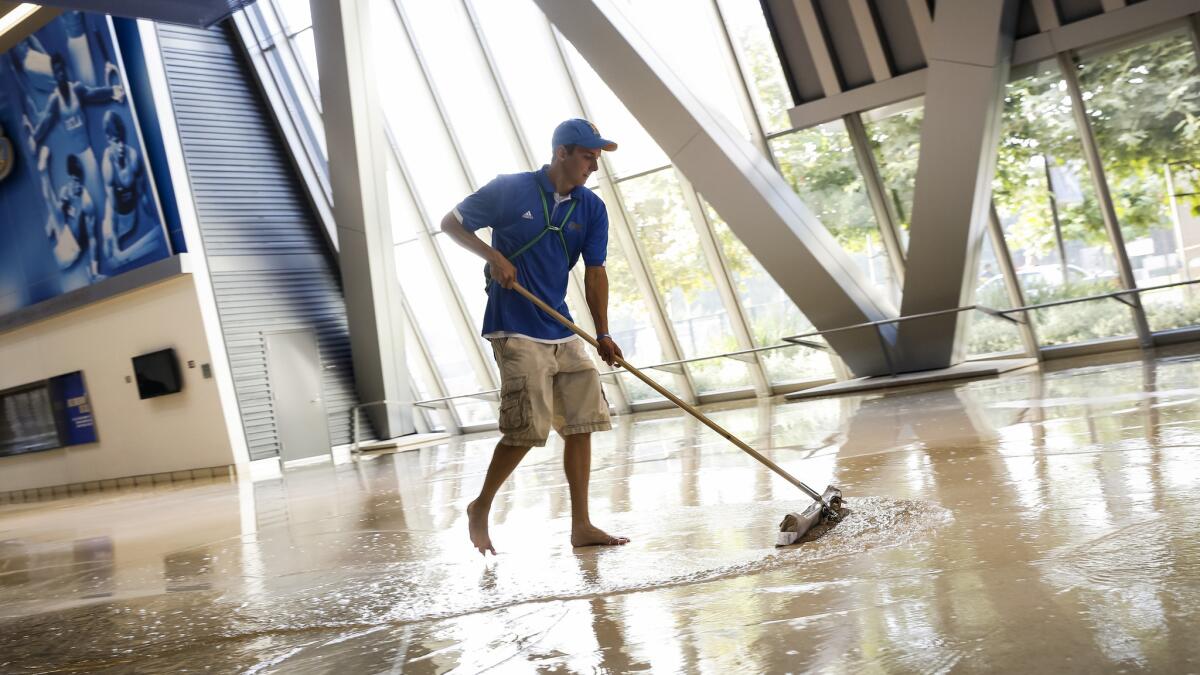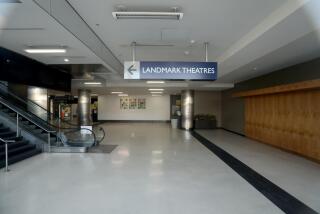Pauley Pavilion, other UCLA sports venues will be ready this fall

- Share via
Pauley Pavilion was filled with fans, though not the kind that clap and cheer.
The kind that spin.
Dozens of fans circulated air as the historic arena began to dry out Wednesday, less than 24 hours after it was flooded by waves of water from a broken main on Sunset Boulevard, and silt picked up along the way.
Athletic Director Dan Guerrero had good news by early afternoon: UCLA’s athletic teams could expect to use Pauley Pavilion and the university’s other athletic venues this fall, as scheduled.
An inspection revealed no structural damage. The hardwood playing surface, which was warped and swelling at the edges, would be replaced along with carpeting, drywall, paint, furniture and equipment, Guerrero said.
The arena, which underwent $136 million in renovations and was reopened in 2012, was hit hardest on its north side, where water leaked into the Pavilion Club and locker-room areas. “But you know, it’s a steel building for the most part,” Guerrero said, “… the main concern really was the court.”
Workers removed peeling paint and crumbling ceiling tiles from the locker-room area and the Pavilion Club on Wednesday morning, but already much of the arena looked to be in normal working condition. Carpeted areas were damp, but the silt that covered the floors in the locker rooms only 12 hours earlier had been removed.
The UCLA women’s volleyball team’s home opener is scheduled for Pauley on Sept. 23, but most of the squad’s matches are played in the Wooden Center, where Guerrero said damage to the court was minimal.
Pauley is scheduled to host Bruins basketball exhibitions for the men’s team on Oct. 31, against Azusa Pacific, and for the women’s team on Nov. 2, against Westmont.
University officials said UCLA’s other athletic facilities, including the Wooden Center, the Ashe Student Health and Wellness Center, the Acosta Center, the student activities center, Spaulding Field and Drake Stadium all appeared to have escaped serious damage.
Spaulding, where the UCLA football team practices, is located in an area away from most of the water and has synthetic turf. The Bruins open training camp Monday, but practice for the first two weeks was already scheduled for Cal State San Bernardino.
Drake Stadium, home of the track and field teams, had been submerged by rushing water Tuesday evening, but by Wednesday afternoon students were jogging on the track.
Stacks of soggy carpet were piled outside the Morgan Center, which houses the primary athletic offices and the UCLA Hall of Fame. But inside, students filled study halls and business appeared to be going almost as usual. Guerrero said that only the carpet needed replacing in the Hall of Fame, which includes a display of the den belonging to famed former basketball coach John Wooden.
The cost of cleanup and repairs is unknown, though campus officials suggested they might have a better idea by the end of the week. Asked if the city of Los Angeles would be picking up the bill, Guerrero said he didn’t know but that he thought insurance would cover it. “I would certainly like athletics to not have to foot any of the bill, and I don’t believe we will,” he added.
The athletic venues became a beehive of activity in the hours following the raging geyser that spewed an estimated 20 million gallons of water onto the UCLA campus and surrounding areas.
Water first trickled onto the east end of the Pauley court about 3:30 Tuesday afternoon, witnesses said. Soon, it poured in faster than workers could remove it.
Clint Svatos, UCLA’s aquatics director, heard about the flooding and came down from the pools to help out.
“The water was only on that quarter of the court when we started,” he said, gesturing to the east end. But “it was a lost cause after a while.”
Guerrero said he didn’t know how many people were involved in the response and cleanup. Workers and volunteers used squeegees, vacuums, brooms and floor cleaners — whatever they could find — as firefighters working in tandem dragged water out of the arena’s concourses with their hoses. Sandbags were set by doorways, tractors moved chunks of earth and blocks of concrete stemmed the flow of water toward stairwells.
The water on the Pauley floor crested at about eight inches, campus officials estimated, but by Tuesday night only about an inch remained.
Guerrero said the damage was limited because of the quick response by workers.
This scene from the women’s basketball locker room Tuesday night was typical:
While water trickled steadily from ceilings and air vents, Pam Walker, director of basketball operations, squeegeed next to Jonah Badrna, a custodian.
“Do you think we’re getting somewhere?” she asked Badrna.
He shrugged, water dripping on his head as he worked.
“No,” he replied.
“OK,” Walker said.
Both kept working.
“We had volunteers, we had staff, we had our student athletics in there with squeegees,” Guerrero said. “It was really a wonderful thing to see.”
Twitter: @zhelfand
Twitter: @cfosterlatimes
Times staff writer Everett Cook contributed to this report.
More to Read
Go beyond the scoreboard
Get the latest on L.A.'s teams in the daily Sports Report newsletter.
You may occasionally receive promotional content from the Los Angeles Times.







